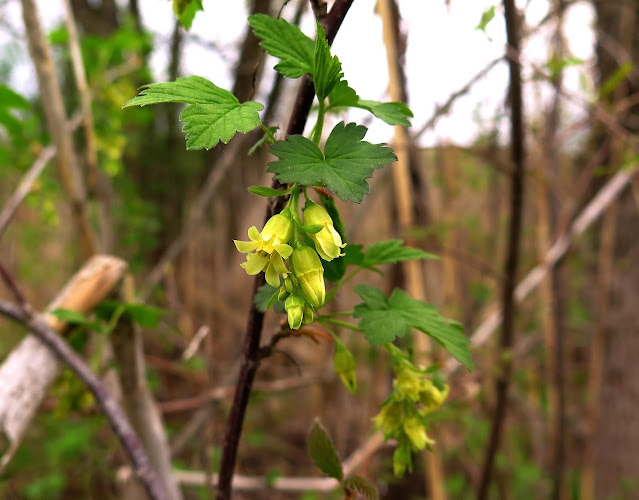Rain, rain, go away! April's OVER! Now it's MAY! But the showers continue, day after day. Sigh!
I've begun to run out of shoes that aren't soggy, but I laced the driest ones up this past Monday to dash off to nearby Bog Meadow Brook Nature Trail, hoping to fit in a walk between showers. And I nearly did, the rain holding off until I had only a few hundred yards left to dash to my car under a downpour.
This is an old photo of the west end of this two-mile-long trail, before it was raised and paved a couple of years ago to compensate for beaver-caused flooding of the trailside wetland.
But this photo still shows the birch-lined section of trail where I search for Nodding Trillium (Trillium cernua) each May. This lovely native wildflower hides beneath the trailside shrubs, and it's always a good idea to locate their early shoots, before the ferns and grasses grow high enough to disguise them.
I didn't really expect to find the Nodding Trillium blooming yet, but considering how cold it has been of late, I was surprised to see them as far advanced as I did, with swelling buds atop fully expanded leaves. (The flower buds will dangle beneath the leaves when they actually open.)
It looks as if it might be a great year for these flowers along this trail. Here was a cluster of four good-sized plants with buds about to burst.
I found many new trillium plants, some already sporting buds while others might still be too young to bloom this year. A few years ago, a state botanist told me that Nodding Trillium seemed to be disappearing from many of the sites from which it once had been reported, so I am very happy to report that this species appears to be secure along Bog Meadow Brook Trail.
My trillium sleuthing successful, I relaxed and enjoyed an easy walk, noting what wildflowers WERE in bloom along the trail. The most abundant flowers were those of Wood Anemone (
Anemone quinquefolia) forming extensive patches of pristine white flowers atop spreading five-parted green leaves.
Wild Strawberry plants (
Fragaria virginiana) dotted the trailside grassy areas, promising a few sweet treats for hikers as the season progresses (if the birds or chipmunks don't eat them first).
Kidney-leaved Buttercup (Ranunculus abortivus) is often overlooked because its flowers are so small, but when these plants grow in abundant numbers as they do along this trail, it looks as if a handful of tiny bright stars were scattered across the ground.
Sessile-leaved Bellworts (
Uvularia sessilifolia) are also easily overlooked, since they dangle their pale-yellow bell-shaped flowers beneath their leaves. It helps to make them easier to spot when they grow massed together in abundant numbers, as these did.
If not for their snowy-white flowers dangling from bright-red budscales, I could easily have walked right by without spotting this isolated tiny shrub of Lowbush Blueberries (
Vaccinium angustifolium).
But I never could have missed the masses of Dog Violets (Viola labradorica) that carpeted the grass by the side of the trail. The flowers are such a pale lavender they almost appear to be translucent, which helps to distinguish this native species of violet from the much-deeper-purple Common Blue Violet. Another distinguishing feature is that these violets bear leaves on their flower stems (the Common Blues have basal leaves only), and the stipules that wrap the leaf nodes are sharply toothed.
The broad green leaves of a patch of Wild Ginger (Asarum canadense) could be spotted from many yards away, but I had to bend down and peer under the leaves to see its unusual brownish flower resting on the ground.
I wish I had brought some blaze-orange tape to mark this Wild Black Currant shrub (Ribes americanum) so that I might find it later in summer, when it bears its juicy tart fruits. The length of the flowers helps to distinguish this native species from the European garden currants or the native Wild Red Currant, both of which bear flowers that are squatter and more saucer-shaped.
No flowers yet, on this Glaucous Honeysuckle (Lonicera dioca), a vining plant that is one of our few native honeysuckles. I sure hope I can find this vine again when those flower buds burst open into a spray of confetti-colored flowers, orange and yellow and coral.
No flowers on this Red Maple tree (
Acer rubrum) either, because the female flowers have faded by now to produce abundant clusters of bright-red winged seeds. I was happy to see this gloriously colorful tree, completing the cycle -- from buds to blooms to seeds -- of beautiful things I found on this pleasant but now growing soggy walk on the Bog Meadow Trail.














You can find flowers wherever you go!
ReplyDeleteYou have plants that we just dream of seeing down here. If it's palatable to deer it's gone here and with no seed source many species may never reappear.
ReplyDeleteBeautiful despite the rain. We are pretty much over it too. We need to get gardening!
ReplyDelete